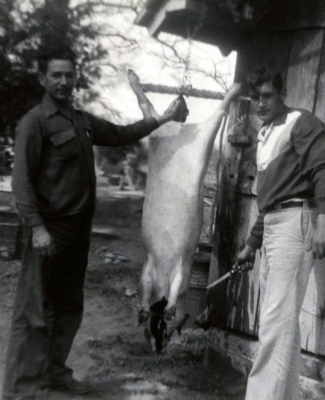
Keeping pigs and chickens for self-sufficiency
 Westmacott
explained that gardening practices of slaves in the American South were
almost as diverse as those
in Africa.
Slaves unlucky enough to
live in upland regions tended to be worked from sunup to sundown under
the heavy thumb of an overseer --- they usually had no time to tend
their own garden, and were seldom allowed to keep livestock for their
own consumption. The "luckier" slaves on large plantations along
the coast were often given a daily quota of chores to pursue at their
own speed, and if they were fast and hard-working, they could make time
to grow their own vegetables and keep a hog and chickens. The
families craved this bit of self-sufficiency, which could mean the
difference between malnutrition and relative health.
Westmacott
explained that gardening practices of slaves in the American South were
almost as diverse as those
in Africa.
Slaves unlucky enough to
live in upland regions tended to be worked from sunup to sundown under
the heavy thumb of an overseer --- they usually had no time to tend
their own garden, and were seldom allowed to keep livestock for their
own consumption. The "luckier" slaves on large plantations along
the coast were often given a daily quota of chores to pursue at their
own speed, and if they were fast and hard-working, they could make time
to grow their own vegetables and keep a hog and chickens. The
families craved this bit of self-sufficiency, which could mean the
difference between malnutrition and relative health.
A focus on pigs and
chickens as a path to meat self-sufficiency carries
through to the modern day in the African-American families Westmacott
interviewed.
Many of the families had either hogs, chickens, or both, and hog
butchering stations in nearly all of the yards showed that the families
not currently keeping pigs used to. Despite the daunting size of
a full-grown pig, about half of the families still slaughtered their
own hogs, explaining that butchers won't return ears and chitterlings,
which the families like to cook with.
Pigs and chickens (and
mules, nearly all of which have been replaced by
tractors and rototillers) made the traditional Southern,
African-American family very self-sufficient. Families used to
feed their food scraps and excess produce to the animals and get meat
and manure in return. This homesteading feature is quickly
disappearing, with purchased fertilizers and grocery store meat now
cheap enough that families see little need to keep their own livestock.
| This post is part of our African-American Gardens and Yards in the
Rural South lunchtime series.
Read all of the entries: |
Want more in-depth information? Browse through our books.
Or explore more posts by date or by subject.
About us: Anna Hess and Mark Hamilton spent over a decade living self-sufficiently in the mountains of Virginia before moving north to start over from scratch in the foothills of Ohio. They've experimented with permaculture, no-till gardening, trailersteading, home-based microbusinesses and much more, writing about their adventures in both blogs and books.
Want to be notified when new comments are posted on this page? Click on the RSS button after you add a comment to subscribe to the comment feed, or simply check the box beside "email replies to me" while writing your comment.
